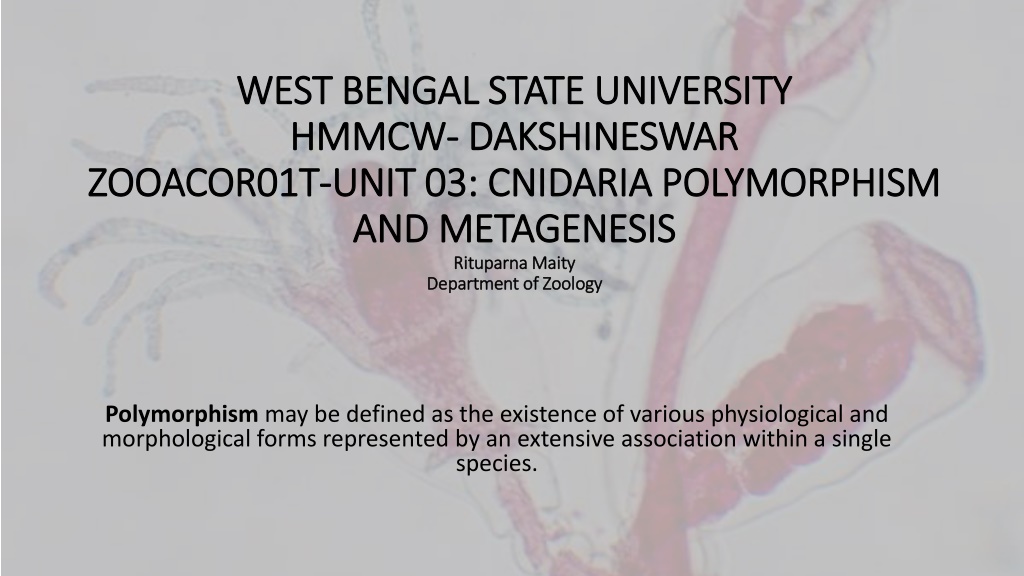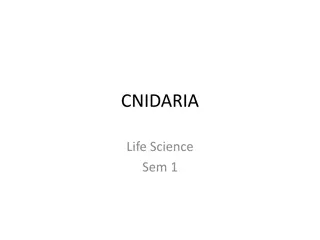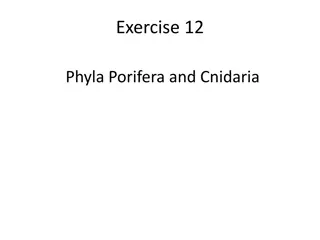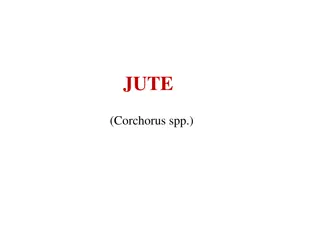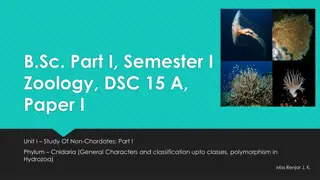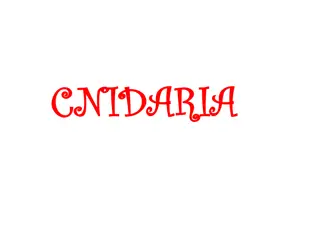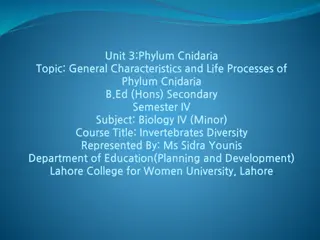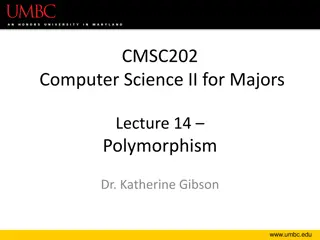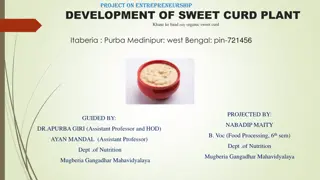Understanding Polymorphism and Metagenesis in Cnidaria at West Bengal State University
Polymorphism in cnidarians refers to the presence of diverse physiological and morphological forms within a single species. This phenomenon leads to the specialization and cooperation of zooids in colonial forms, eventually functioning collectively for the colony's benefit. The structural characteristics, symmetry variations, and specialized zooids like gastrozooids and dactylozooids are key aspects of polymorphism in cnidarians. The reproductive processes involving gonozooids and gonangia contribute to the unique life cycle of hydrozoans, with examples of polymorphism found in Siphonophora and Pennatulacea. Understanding polymorphism and metagenesis in cnidarians offers insights into their complex biological adaptations and ecological roles.
Download Presentation

Please find below an Image/Link to download the presentation.
The content on the website is provided AS IS for your information and personal use only. It may not be sold, licensed, or shared on other websites without obtaining consent from the author. Download presentation by click this link. If you encounter any issues during the download, it is possible that the publisher has removed the file from their server.
E N D
Presentation Transcript
WEST BENGAL STATE UNIVERSITY WEST BENGAL STATE UNIVERSITY HMMCW HMMCW- - DAKSHINESWAR DAKSHINESWAR ZOOACOR01T ZOOACOR01T- -UNIT 03: CNIDARIA POLYMORPHISM UNIT 03: CNIDARIA POLYMORPHISM AND METAGENESIS AND METAGENESIS Rituparna Maity Rituparna Maity Department of Zoology Department of Zoology Polymorphism may be defined as the existence of various physiological and morphological forms represented by an extensive association within a single species.
The existence of individuals of a single species in more than one forms and functions is called zooids. diversifica diversification of forms and specialization tion of forms and specialization.In the colonial forms, disoperation ceases gradually and is replaced by cooperation. Finally the whole colony appears as a single individual, and the zooids function collectively for the interest of the colony (Barrington 1979). zooids.Polymorphismis due to the division of division of labour labour, , Polyps are tubular structures with an outer epidermis, an inner gut sac ( coelenteron) lined with gastrodermis, and a layer of jelly-like mesoglea or mesenchyme in between. The fundamental polypoid symmetry is radial, although as a result of subtle modifications most species possess a biradial or quadriradialsymmetry. When this occurs, the hydroids are said to be thecate; hydroids whose perisarcs do not extend around the zooids are athecate. The term hydranth or gastrozooid refers to feeding zooids, which typically bear tentacles and a mouth. Gastrozooids capture and ingest prey and provide energy and nutrients to the rest of the colony. Defensive polyps (dactylozooids) Dactylozooids, which occur in a variety of sizes andshapes, are heavily armed with cnidae. Often several dactylozooids surround each gastrozooid and serve for both defense and food capture. The main body axis runs longitudinally through the mouth (oral end) to the base (aboral end) of the polyp. The aboral end may fom a pedal disc for attaching to hard substrata (as in most common sea anemones); it may be a rounded structure-called a physa. The mouth may be set on an elevated hypostome or manubrium as in hydrozoans. The hypostome is surrounded by a circle of numerous (about 24) tentacles. The tentacles are longer than hypostome, tapering and filiform.The coelenteron, or gastrovascular cavity, serves for circulation as well as digestion. Reproductive polyps (gonozooids or gonangia). . Gonozooids produce medusa buds called gonophores that are either released or retained on the colony. Whether released as free medusae or retained as attached gonophores, they produce gametes for the sexual phase of the hydrozoan life cycle. The living tissue (coenosarc) of the gonozooid is called the blastostyle; the gonophores arise from this tissue. When a gonotheca surrounds the blastostyle, the zooid is called gonangium (Gr., gonos = seed; angeion = vessel), club-shaped, cylindrical form. Branched hydrozoan colonies grow in two patterns. In monopodial growth, the first polyp elongates continuously from a growth zone at the distal end of the simple or branched stem of the colony, the hydrocaulus. Each zooid typically arises from a stalk, called a hydrocaulus. The most dramatic examples of polymorphism among polyps- hydrozoan order Siphonophora and the anthozoanorder Pennatulacea. Siphonophores are hydrozoan colonies composed of both polypoid and medusoid individuals, with as many as a thousand zooids in a single colony. Siphonophores use one or more swimming bells (nectophores) or a gas-filled float (a pneumatophore), or both, to help maintain their position in the water. In most colonial hydrozoans, the individual polyps are anchored in a rootlike stolon called a hydrorhiza, which grows over the substratum. From the hydrorhiza arise the hydrocauli, bearing polyps singly or in clusters. The new polyps extend the colony upward some distance then stop growing and give rise to more new polyps by budding. In these colonies the main stem or axis actually represents the combined hydrocauli of many polyps and the age of the polyps decreases from base to tip along each branch. A complex terminology has been developed to describe hydrozoan polyps, or "hydroids" as they are commonly called. hydroid colonies are usually polymorphic, containing more than one kind of polyp, or zooid. Most marine hydroids are surrounded, at least in part, by a nonliving protein chitin exoskeleton secreted by the epidermis and called the perisarc. The living tissue inside the perisarc is termed the coenosarc. The perisarc may extend around each hydranth and gonozooid as a hydrotheca and gonotheca, respectively. 2 .
The medusa medusa is a modified zooid produced as a hollow bud from the coenosarc of the blastostyle in spring and summer. Medusa swims freely on the surface water. Although variation in form exists, medusae are far less diverse than polyps and it is much easier to generalize about their anatomically. The relative uniformity of medusae is largely a result of their usually similar lifestyles in open water, and of their inability to form colonies by asexual reproduction. Medusae are bell-, dish-, or umbrella -shaped, and usually in, imbued with a thick, jellylike mesogleal layer (hence the name jellyfish, or simply "jellies"); Nectophore/nectocalyx: medusa capable of free-swimming. The convex upper (aboral) surface is called the exumbrella; the concave lower (oral) surface is the subumbrella. The mouth is located in the center of the subumbrella, often suspended on a pendant, tubular extension called the manubrium, which is almost always present on hydromedusae. The coelenteron or gastrovascular cavity occupies the central region of the umbrella and extends radially in the body via radial canals. In most hydromedusae (medusae of the class Hydrozoa), a marginal ring canal within the rim of the bell connects the ends of the radial canals. The presence of four radial canals and of tentacles in multiples of four (in hydromedusae) and the division of the stomach by mesenteries into four Polyps Longitudinal section through polyp Cross section of retracted polyp Longitudinal canal. Fine gastodermal canals connect polyps with each other and the major (longitudinal) canals (solaua) gastric pouches (in scyphomedusae) give most jellyfish a quadriradial (= tetramerous) symmetry. Most hydromedusae have a thin circular flap of tissue, the velum, within the margin of the bell. Life-history : The male gamets or spermatozoa, after maturation, liberated into water and one spermatozoon fertilizes a female gamet or ovum- the planula larva is produced. The life history may be represented as male and female gametes zygote planula larva hydrula colony sexual medusae gametes zygote and so on. Planula Larva: Elongated and ovoid appearance. Mouth is absent, contains a cavity which is the primordial coelenteron. After planula larva settling down and fixes itself to the substratum by one pole and transforms into the next stage- hydrula stage. Hydrula Stage: Fixed end aboral and free end oral end. After formation of manubrium and circlet of tentacles the mouth is formed at centre at the manubrium. Then hydrula develops into a Obelia colony. Pneumatophore/float: Hydrostatic in function and is represented by an inverted medusoid without any mouth and tentacles, external exumbrellar wall: pneumatocodon, internal subumbrellar wall: pneumatosaccus or air sac. Original opening of air sac is upward with sphincter muscle, At the bottom of the air sac usually lined with ectodermand expanded into a chamber termed as trichter or funnel, with gas gland. Gonophore: reproductive zooid look like medusa, dioecious Bract: They have thick gelatinous prismatic Leaf-like, helmet shaped, simple or branched; studded with nematocytes. Also known as hydrophilla, phyllozooid. Aurophores: A part of pneumatophore of ovoidal structure becomes partially constricted off to form a bell-like aurophore, can communicate with outer structure. 5
ORIGIN OF POLYMORPHISM ORIGIN OF POLYMORPHISM There are many theories to explain the origin of polymorphism in cnidarians is virtually regarded to the division of labour,where different zooids perform diverse functions. As regards the origin of polymorphism in cnidarians, the following theories have been advanced: Poly-organ theory: This theory was proposed by Huxley (1859), Eschscholtz (1829), E. Metschnikoff (1874) and Muller (1871). According to this theory, a polymorphic colony is supposed to be a single medusoid zooid; its various components are regarded to be the modified organs of this medusoid zooid. The various parts of the zooid, i.e., manubrium, tentacles, umbrella, etc., multiply independently from one another and they have assumed different forms to perform different functions. Poly-person theory: This theory was first proposed by Leuckart (1851), Vogt (1848), Gegenbaur (1854), Kolliker (1853), Claus (1863) and later strongly supported by E. Haeckel (1888), Balfour (1885) and Sedgewick (1888). According to this theory colony is not a single individual but various parts of the colony are modified individuals which have changed their structure due to division of labour. They have all modified from the primitive zooid which was a polyp. Medusa theory: This theory was proposed by Haeckel (1888) as a compromise between the above theories. The theory says that the siphonophores formed from gastrula was a medusoid individual, from which zooids or persons appeared by budding from the subumbrella. 6
Metagenesis Metagenesis: Metagenesis refers to alteration of generation by representing two generations in successive developmental stages, one is sexual stage or medusa and other is asexual stage or polyp. The polypoid generation is asexual and produces polyps and blastostyles by asexual budding. The blastostyle also produces medusae by asexual budding. The medusae do not produce medusae but they give rise to gametes, which after fertilisation develop into a polypoid colony from which medusae are produced again by budding. an asexual polypoid generation alternates with a sexual medusoid generation. This phenomenon is known as alternation of generations, till recently. The term alternation of generations means that the individual exists in two distinct forms, which alternate each other regularly in the life history. One individual possesses the power to reproduce the other by asexual reproduction, which again by sexual reproduction gives rise to the next generation. Therefore, a true alternation of generations is always between a diploid asexual and haploid sexual generations, as is exhibited by fern plant. Example for metagenesis-Life-Cycle of Obelia: The sedentary hydroid colony alternates with the pelagic medusa phase. Hydroid colony reproduces by asexual budding to produce hydranths and blastostyles. Medusae are also produced by budding from blastostyle but they are free swimming sexual forms that carry ova and sperms in four gonads and disperse them in water far and wide. Medusae are the sexual zooids or gonozooids possessing gonads. They are dioecious, i.e. testes and ovaries are borne by separate individuals. Each medusa bears four gonads on the subumbrellar surface, one in the middle of each radial canal. Each gonad is an ovoid, knob-like body having an outer epidermis and an inner lining of gastrodermis. Gametes are placed between the two layers. Outer wall of mature gonads ruptures to release the gametes in water. Fertilization occurs in sea water where the gametes are set free. Parent medusae die soon after liberating the gametes. Fertilized egg or zygote undergoes holoblastic cleavage, resulting in a solid morula, which then transforms into a hollow ball of cells called blastula. Blastula is made of blastomeres and encloses a cavity called blastocoel. Gastrulation takes place by delamination of the endodermal cells from one end of blastula, eventually filling the blastocoel completely. Such solid gastrula is called stereo gastrula in which the outer layer of cells is the ectoderm and the inner mass of cells filling the blastocoel is endoderm. Gastrula elongates and forms an elongated free-swimming ciliated planula larva that swims about in search of a suitable substratum for fixing to form a sedentary colony. Soon the solid endoderm splits and develops a cavity, the enteron. Now the fixed planula becomes a truly two-layered larva with an outer ciliated ectoderm and an inner endoderm. The larva now closely resembles a simple polyp and is called hydrula. By budding, hydrula gradually grows into a branching Obelia colony. 7
Life-Cycle of Aurelia 9
